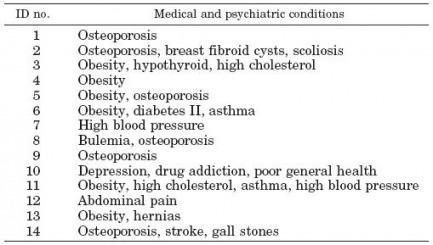This web page was produced as an assignment for Genetics 677, an undergraduate course at UW-Madison.
Complete Androgen Insensitivity Syndrome: Long-Term Medical, Surgical, and Psychosexual Outcome

The purpose of the paper is to discern the effect of the time of treatment or use of treatment on women (n=14, age range=20s to mid-60s, median age=45 years) with complete androgen insensitivity syndrome (CAIS). All individuals were examined by doctors at John Hopkins as well as asked questions relating to physical, psychosexual, and treatment of the disoder .
These women identified as women in the study. They were all diagnosed by most importantly the presence of an androgen receptor (AR) mutation. This mutation indicates that the women have androgen insensitivity disorder (AIS) and not another intersex disorder. Other criteria included feminization before puberty, presence of testes, female genitalia, and Y chromosome, and little to no post puberty auxillary hair.
In regard to physical characteristics, they were no different in birth weight or vaginal appearance. They were different in that they had greater birth heights and less if any pubic hair. The psychosexual effects were mostly normal when compared to the larger population. They experienced approximately the same sexual gratification and libido as women who are XX. They also viewed themselves as highly feminine and were uncomfortable with the third sex category. The study could not conclude if there is a higher incidence of obesity or bone related diseases to the syndrome. The women indicated that they would prefer treatment, including gonadectomies and vaginoplasty either as an adolescent or adult.
The authors concluded from the study that treatment should be postponed and further investigation into disease correlation and long term effect of treatment should be conducted.
Figures: Tables 1 and 2
Table 1: Table summarizing age, race, AR mutation, age at time of surgery, and appearance of genitalia.
This table summarize the physical characteristics of the individuals as well as reports time of surgery in their lives. From this table in comparison with XX women, there are no discernible differences in appearance of the clitoris or vagina. However, as expected based on the syndrome, the women had little to know pubic hair. However, the fact that some women did have hair in their pubic areas indicates a non-androgen regulated mode of hair growth there.
Table 2: Physical and mental illnesses experienced by subjects
There appears to be correlation between osteoporosis and the syndrome. However, based on the small sample size, the statistical power of the study is very weak. Obesity was high among elderly women in the study, but this effect could be no different than normal for their age group. Subject number 10's psychological problems are likely due to other variables.
Personal feelings about article
I found that the number of subjects makes practically all the results a good start but by no means a definitive answer to any of the questions. Other studies must include more subjects in some way. Understandably, this is a rare syndrome with incidence of 1 in 20,000 (2). The only solution for phenotypic studies is to include more than just CAIS cases. The inclusion of partial and mild AIS may make comparisons difficult as these individuals may have very different experiences due to more obvious genitalia ambiguity in childhood. Hence, treatment for these individuals may be made without their knowledge or consent. This situation may render comparisons of the effects of treamtent impossible. Another solution to the low number of subjects could be to include individuals with similar syndromes.
Beyond the low subject number, I found the article to be interesting, but lacking any powerful assertions. It appeared that it lightly stated that future studies should look into the long term effect of treatment. I thought that was the point of this paper.
I was happy to see the inclusion of sexual orientation in the paper. The one women identifying as lesbian had experienced abuse at a young age, which may have influenced here sexual orientation more so than her syndrome. It appears likely that many women with CAIS will not experience gender confusion at a young age and subsequently a homosexual orientation in adulthood. Another study including a larger sample size as well as a case matched control for each individual found no real difference between those with CAIS and other women as far as sexual orientation or quality of life (3). As established in previous studies, cross-linked gender behaviors correlated highly with homosexual orientation in adolescents/adulthood for both men and women (4). Cross-linked behaviors include playing with toys more associated with the opposite sex or playing more with kids of the opposite gender prior to puberty.
Other than the small sample size, I found the article to be interesting at the very least. I learned a lot more about the phenotype in the complete case than I had previously known. They are phenotypically women. They have what appear to be fully functional vaginae and clitoris at least in shape and size. Many of them in fact grow up not even knowing. Note that the ignorance to their syndrome is not due to parental protection in most cases. Often times, these individuals are not diagnosed until they fail to menstruate. I would say that in the future, studies need to include larger sample sizes and have better controls, as in not just comparing the individuals to the general public.
References
1. (Tables 1 and 2) Wisniewski, A., Migeon, C., Meyer-Bahlburg, H., Gearhart, J., Berkovitz, G., Brown, T., Money, J. (2000). Complete Androgen Insensitivity Syndrome: Long-Term Medical, Surgical, and Psychosexual Outcome. Clinical Endocrinology and Metabolism 85(8). Retrieved from: http://jcem.endojournals.org/cgi/content/abstract/85/8/2664
2. Galani, A., Kitsiou-Tzeli, S., Sofokleous, C., Kanavakis, E., Kalpini-Mavrou, A. (2008). Androgen insensitivity syndrome: clinical features and molecular defects. HORMONES 7(3). Retrieved from: http://hormones.gr/preview.php?c_id=227
3. Drummond, K., Bradley, S., Peterson-Badali, M., Zucker, K. (2008). A follow-up study of girls with gender identity disorder. Developmental psychology 44(1): doi: 10.1037/0012-1649.44.1.34
4. Hines, M., Ahmed, S., Hughes, I. (2003). Psychological Outcomes and Gender-Related Development in Complete Androgen Insensitivity Syndrome. Archives of Sexual Behaviors 32(2). doi: 10.1023/A:1022492106974
Website authored by Sam Trammell. Email: [email protected]. Last updated: March 13, 2009.


